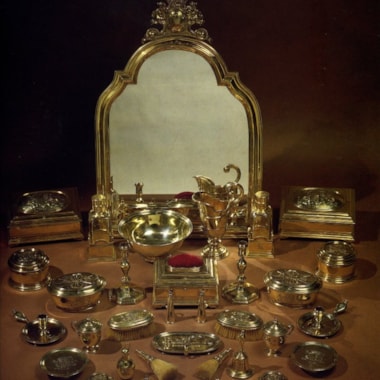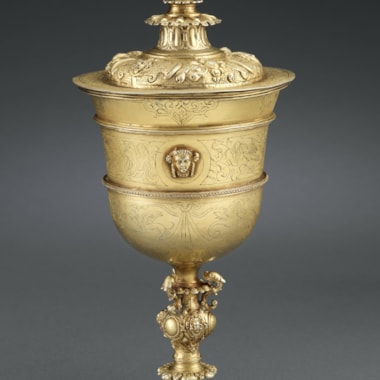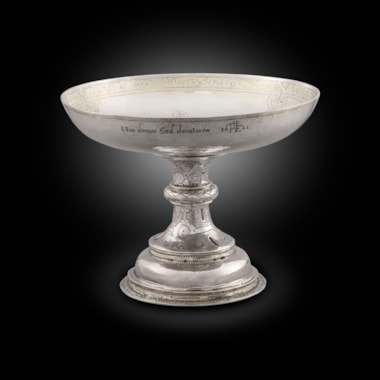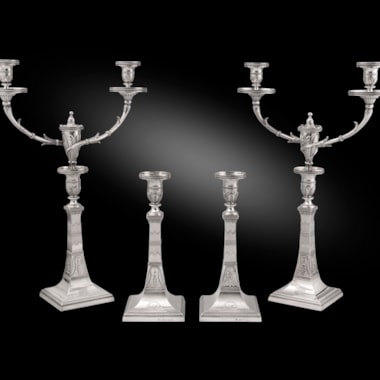The dish with guilloche border, separated by four columns into finely-chased scenes, one with pricked arms below a cardinal's hat, centered by a pedestal decorated with oves and supporting a fully-modeled figure of the Emperor in classical armor, crowned with a laurel wreath and holding a fleur-de-lys scepter, the patterned cloak held to his shoulders by two decorated screws, the pedestal engraved VESPASIANUS; the stepped foot and baluster stem chased with bands of profile heads, trophies of classical weapons, clusters of fruit, and masks, below openwork brackets and a disk with border of entrelac apparently unmarked except for 19th century French control mark on rim of dish, pedestal, and cloak of figure.
This work is one of the series of Emperor tazze that John Hayward called, “the most impressive single monument of Italian and perhaps of European goldsmiths’ work of the sixteenth century.”
Early History
Stefanie Walker discovered the set of twelve tazze recorded in the 1603 inventory of Cardinal Pietro Aldobrandini (1571-1621), one of the great collectors and patrons of late Renaissance Italy:
Dodici Tazzoni grani col piede alto, lavorati con diverse historie di basso relieve, con un Imperatore in piedi spora ciascuno, segnati ciascun pezzo col contrscritto n.o. 52, pesano tutti insieme libre centonove, oncie undici e meza lb. 109 on’11 ds[?] 12
[Twelve large cups, on a high foot, worked with various narrative scenes in low relief, with a standing emperor on each, each piece marked with the number 52, all together they weigh 109 pounds 11 ½ oz.
Pietro’s success came as nephew to Pope Clement VIII Aldobrandini (1535-1605). After his uncle’s election in 1592, the 22-year-old Pietro was created Cardinal of San Nicola in Carcere the following year. His triumph, though, was the restoration of the Duchy of Ferrara to the Papal States after the death of Alfonso II d’Este without heirs in 1597. A combination of adroit negotiation and an almost unopposed army allowed Pietro to install himself as Papal Legate, and he sequestered many of the d’Este treasures left behind, such as The Feast of the Gods, by Bellini and Titian (now National Gallery, Washington, Widener Collection). Having also negotiated the return to the Catholic Church of Henri IV of France, Pietro was sent as legate to bless the King’s marriage to Catherine de Medici in Florence in 1600.
Pietro’s architectural patronage included the Villa Aldobrandini at Frascati, with its fabulous gardens and fountains. He was a patron of Torquato Tasso, Frescobaldi, Domenichino , and Guido Reni, and his art collection – part of which still forms the basis of the Gallery Doria-Pamphili – included works by Raphael and Mantegna. In precious metal, he was sufficiently involved to be a patron of Pietro Spagna. The 1603 inventory is a sort of vanity catalogue of the Cardinal’s acquisitions and collection, a carefully written testament to his success.
Cardinal Pietro was named Archbishop of Ravenna in 1604, and he continued to accumulate positions and riches even after the death of his uncle the Pope. As early as 1600, Pietro named as heir his sister Olimpia, wife of Giovanni Francesco Aldobrandini. On the Cardinal’s death in 1621 his properties and collections, including the Emperor Tazze, passed to her; they remained with her descendants for almost two centuries.
Design
The theme of the “Twelve Caesars” was set out by Gaius Suetonius Tranquillis, secretary to the Emperor Hadrian, in his work De Vita Caesarum, written in 121 AD. A first Renaissance edition of Suetonius appeared in 1470, followed by other reprints and translations including one by Erasmus of Rotterdam. Series of the emperors, in profile like ancient coins, were made in medals, engravings, and Limoges enamels. Thus, figures and their stories would have been recognizable to enlightened patrons such as Cardinal Pietro and his guests.
David McFadden linked the armored figures of the Caesars on the set with engravings of the Emperors in classical armor on horseback, created by Stradanus, a Northern artist active at the court of the Medici in the late 16th century. The debate between Northern and Italian creation has raged over these pieces for decades, with different scholars arguing for a Northern influence in the design, in the architecture of the buildings, in a print source of the design, in the person of the chaser, or even claiming Augsburg for both the conception and creation of the suite. Current opinion seems to favor a Northern artist working in Italy.
Certainly the chaser had access to sources beyond Suetonious, as the tazze show antiquarian details that do not occur in that text. On this Vespasian tazze, the view of Judea carefully depicts the circuit of three walls around Jerusalem, with the central Temple; this would need to come from an account such as Josephus The Jewish War, rather than just an interpretation of Suetonious. The depiction of the Circus in the Circus Maximus in the Caligula bowl has been compared with a 1552 engraving of the Circus Flamini by the French-born Nicolas Beatrizet, working in Rome, after a drawing by the Papal antiquiary Pirro Ligorio. This combination – for one detail - evokes the incredible internationalism of the Italian Renaissance world that created the Emperor Tazze.
For the Vespasian bowl, each of the four scenes corresponds to a passage from Suetonious. The first shows the Conquest of Judea:
A firm persuasion had long prevailed through all the East, that it was fated for the empire of the world, at that time, to devolve on some who should go forth from Judaea. This prediction referred to a Roman emperor, as the event shewed; but the Jews, applying it to themselves, broke out into rebellion, and having defeated and slain their governor routed the lieutenant of Syria, a man of consular rank, who was advancing to his assistance, and took an eagle, the standard, of one of his legions. As the suppression of this revolt appeared to require a stronger force and an active general, who might be safely trusted in an affair of so much importance, Vespasian was chosen in preference to all others, both for his known activity, and on account of the obscurity of his origin and name, being a person of whom there could be not the least jealousy. Two legions, therefore, eight squadrons of horse, and ten cohorts, being added to the former troops in Judaea, and, taking with him his eldest son as lieutenant, as soon as he arrived in his province, he turned the eyes of the neighboring provinces upon him, by reforming immediately the discipline of the camp, and engaging the enemy once or twice with such resolution, that, in the attack of a castle, he had his knee hurt by the stroke of a stone, and received several arrows in his shield.
Once, while he was at dinner, a strange dog, that wandered about the streets, brought a man's hand, and laid it under the table. And another time, while he was at supper, a plough-ox throwing the yoke off his neck, broke into the room, and after he had frightened away all the attendants, on a sudden, as if he was tired, fell down at his feet, as he lay still upon his couch, and hung down his neck.
A poor man who was blind, and another who was lame, came both together before him, when he was seated on the tribunal, imploring him to heal them, and saying that they were admonished in a dream by the god Serapis to seek his aid, who assured them that he would restore sight to the one by anointing his eyes with his spittle, and give strength to the leg of the other, if he vouchsafed but to touch it with his heel. At first he could scarcely believe that the thing would any how succeed, and therefore hesitated to venture on making the experiment. At length, however, by the advice of his friends, he made the attempt publicly, in the presence of the assembled multitudes, and it was crowned with success in both cases.
Returning now to Rome, under these auspices, and with a great reputation, after enjoying a triumph for victories over the Jews… When the men belonging to the fleet, who travelled by turns from Ostia and Puteoli to Rome, petitioned for an addition to their pay, under the name of shoe-money, thinking that it would answer little purpose to send them away without a reply, he ordered them for the future to run barefooted; and so they have done ever since.
Later History
With the death of Cardinal Pietro Aldobrandini in 1621, his extensive possessions passed to his sister, Olimpia Aldobrandini, and on her death in 1637 they went – according to the rules of primogeniture established by Pietro – to her eldest living son, Cardinal Ippolito Aldobrandini (1592-1637). He enjoyed this inheritance for only a year before his own death, but the tazze appear in his posthumous inventory in 1638:
Dodici tazzoni Grandi il piede alto lavorati con diverse historie di basso relieve con Imperator in piede sopra ciascuno, segnati ciascun pezzo col. N.o 52 pesano tutti insieme libre centonove, oncie undici e mezza lib. 109: on 11 ½
[Twelve large tazze on a high foot, each worked with historical scenes in low relief, with Emeprors standing on top of each one, each piece signed with the number 52; altogether they weigh 109 pounds, 11 ½ ounces].
The Aldobrandini inheritance passed to Ippolito’s niece, Olimpia (1623-1682), called the Princess of Rossano, making her one of the greatest heiresses of her day. She married appropriately, first to Prince Paolo Borghese (d. 1646), then to Camillo Pamphili (d. 1666), a Cardinal and nephew of the current pope, who had to renounce his ecclesiastic position to take this marital prize. This uniting of three of the most prominent Roman families led to discord after the Princess’ death in 1682, when each of the three families claimed part of the Princess’ inheritance.
The twelve tazze are listed in the Guardaroba of the Pamphili palace on the Corso in 1710, after the death of Prince Giovanni Battista Pamphili, Duke of Carpineto, Olimpia’s only son with Prince Pamphili:
Dodici tazzoni grandi d’argento con piedi alti historiato di baso relieve con un Imperatore in piedi spra ciascheduno. Pesano tutti insiemi libre cento nove et onci otto.
[Twelve large dishes with tall bases, with historical scenes in low relief and a large standing figure of an emperor on each. They weigh 109 pounds and 8 ounces].
However, the legal battle between the heirs of the Princess of Rossano was still underway, and the tazze are listed in 1769 as part of the silver from the Aldobrandini collection attributed to the Borghese family:
Argeni Aldobrandini consegnati dal Sig.r Pnpe. Doria Pamphilj all ‘Ecc.ma. Casa Borghese a terno dell’Inventario di Febraro 1769…
1. Dodici Fruttiere antiche di argento tt.e cisellate, ed istoriate con sopre ciascuna la Statua di uno dei 12 Cesari di argento di carlino di peso 110:7.
[Twelve antique Fruit dishes of silver, chased and decorated, each with a statue of one of the 12 Caesars, weighing 110 pounds 7 ounces].
Following the path of paintings from Cardinal Pietro Aldobrandini’s collection that were handed over at the same time, the Emperor Tazze were probably relinquished by the estate of Cardinal Girolamo Pamphili, who died in 1760, to Paolo Borghese Aldobrandini, residing at the Palazzo Borghese. After the latter’s death in 1792, at least some of the paintings passed to his nephew, Giovanni Battista Borghese Aldobrandini, at the Villa Aldobrandini; their history offers a possible way that the Emperor tazze survived the melts inflicted on the Roman aristocracy after Napoleon’s occupation of Rome in 1798, and how they arrived in England.
Alexander Day (c. 1751-1841) was an artist and dealer established in Rome by 1774, part of the group around Angelica Kauffman. In the 1790s he purchased two Aldobrandini works that had descended from Pietro and been restituted to the Borghese branch in 1768: Mantegna’s Adoration of the Shepherds and Annibale Carraci’s Coronation of the Virgin, both now in the Metropolitan Museum. He also handled at least two other works that had belonged to Pietro and Giovanni Battista Pamphili, although it is not clear if they were part of the Borghese group: Raphael’s Aldobrandini Madonna and Caracci’s Domine, Quo Vadis? both in the National Gallery, London. All of these were sold by Day to British collectors between 1792 and Day’s permanent return to London in 1815. Day is known to have dealt in “modern” sculpture as well as paintings, and given his business with the Aldobrandini heirs it seems possible he sent the twelve Emperor tazze to London during the Napoleonic era.
The suite is recorded in the English capital in 1826, when they were exhibited by Kensington Lewis, a retail goldsmith who specialized in antique plate and plate made in the antique taste. The tazze were the subject of an article in Ackerman’s Repository, where the “twelve very curious silver ornaments… by the celebrated Italian artist, Benvenuto Cellini” were described and a romantic story of their recent history related:
They were executed by Cellini about the year 1560, for the celebrated Cardinal Aldobrandini, afterwards Pope Clement VII, whose arms are introduced on several spaces of the chasing, and passed into the family of Borghese, his successors. They were reckoned till 1792 among the chief ornaments of the Aldobrandini palace, and were then carried off and buried, to save them from the rapacity of the French. They afterwards became, in what manner we are not informed, the property of one Dominichi, who was steward to the family at that perilous period; at his death they came by purchase into England… while the money paid for them is expended in charities and masses for the good of the soul of the last possessor.
In 1834 the tazze were sold by the auctioneer G.H. Robins on behalf of another retail goldsmith, Thomas Hamlet, who was in financial difficulties; the Cellini name is repeated in an advertisement in the Times. They were next acquired by the collector and patron Charles Scarisbrick (1800-1860), one of the wealthiest commoners of his era. After a lawsuit over the family estates was finally resolved in 1838, he had an annual income of £40,000, which he increased by almost half before his death. An eccentric recluse, he collected paintings, furniture, carvings and works of art, and employed the young A.W.N. Pugin to extend his house, Scarisbrick Hall, Lancashire. At his death in 1860, most of his collections were sold to provide for his three illegitimate children.
The suite of twelve Emperor Tazze appeared at Christie’s, London, on May 15, 1861 – the last time they were recorded together. In the section of white silver, indicating that the tazze were not yet gilded, they are described as:
The celebrated Aldobrandini Caesar Tazzas, of very elegant form; the dishes, each with four minute subjects of Roman history, embossed; the stems and feet fluted; each tazza is surmounted by a beautiful figure of a Roman Emperor: attributed to Cellini… The whole is executed in silver with extraordinary care and finish. They belonged originally to the celebrated Cardinal Aldobrandini.
After the Scarisbrick sale, the cohort of Emperors took separate routes. According to a 1914 account, “the purchaser [in 1861] was old Mr. Attenborough of the Strand. He sold eleven to Mr. Spitzer for £5,000 apiece… in due course Spitzer placed five in the princely homes of the Rothschilds at about £59,000 a dish, and we know there is one in the Pierpont Morgan collection.”
Frédéric Spitzer (1815-90) was born in Vienna but moved to Paris by 1852, where he purchased a mansion in the 16e arrondissement that he christened the Musée Spitzer. Here, as a contemporary recalled after his death, “during twelve years [1878-90], the mansion on the rue de Villejust saw the pilgrimage of all of the European aristocracy – aristocracy of birth, of talent, or of wealth;” notable purchasers included the Rothschilds and Sir Richard Wallace. However, even by the time of the dealer’s death, his tendency to restore and improve pieces was being noted.
Thus, it is typical of Spitzer that when six of the Aldobrandini tazze, including Vespasian, reappeared in the lavish auction of his collection in 1893, they had acquired new and more elaborate Spanish-style bases. One such base, with the figure and bowl of Julius Caesar, is in the collection of the Lazaro Galdeano Museum in Madrid, and has been catalogued as Castilian, circa 1575, from the Alcala region. This is presumably the model from which others were adapted, as the foot on the offered lot is a 19th century creation. The “Spanish” feet are also on the tazze in the Metropolitan Museum of Art, New York, the Victoria & Albert Museum, London, the Royal Ontario Museum, Toronto, and one sold from the Luton Hoo collection in 2000, with the figure of Titus but a later cast bowl.
Much of Spitzer’s Renaissance-style metalwork was done by the Aachen goldsmith Reinhold Vasters (1827-1909). While his work mounting hardstones is better known today, the Vasters drawings in the Victoria & Albert Museum include several designs for Renaissance-style silver-gilt tazze. The stem on one design, of masks linked by swags of fruit, is quite close to the knop on the bases added to the Aldobrandini tazze. However, there is more direct evidence for Vasters’ association with Spitzer’s tazze; listed in the Aachen sale of the goldsmith’s effects in 1909 are, “two large silver basins, gilded inside, from a set of twelve, representing the history of the Caesars. Replicas after Augsburg works of the sixteenth century [how the tazze were described in the Spitzer sale] a) Vespasian… b) Vitellius …” These basins, probably electrotypes, correspond to two of the tazze that received Spitzer’s new bases. Additionally, Vasters made a hardstone figure of Vitellius in ancient armor, based on the figure from the Emperor tazza, and with an elaborated hardstone base for which Vasters’ drawing is the V&A.
After the 1893 auction, much of the Spitzer collection ended up going to American buyers. The Vespasian tazza was no exception, going to one of the most aggressive collectors of the day, J.P. Morgan (1837-1913). Morgan began collecting in a serious way after his father’s death in 1890, and his taste was very much along the Rothschild-Spitzer lines. Morgan owned the Vespasian tazza by 1901, when it was shown at the Burlington Fine Arts Club exhibition, and it was featured in his 1908 catalogue by E. Alfred Jones. The tazze was not included in the gifts made after Morgan’s death to the Metropolitan Museum and the Hartford Atheneum (which received many of the decorative arts previously kept in London), but was retained by the Morgan family until its sale in 1982.
Cardinal Pietro Aldobrandini (1571-1621), recorded in his 1603 inventory, to his sister
Olimpia Aldobrandini (1567-1637), to her son
Cardinal Ippolito Aldobrandini (1592-1638), recorded in his posthumous inventory in 1638, to his niece
Olimpia Aldobrandini-Borghese (1623-1682), Princess of Rossano, to her son
Giovanni Battista Pamphili (1648-1709), Duke of Carpineto, recorded in his posthumous inventory in 1710
In 1769 to the Borghese branch of the family
In 1826 with retail silversmith Kensington Lewis, St. James St. , London
With retail goldsmith Thomas Hamlet, Princes St., London, his sale
George Robins (auctioneer), London, February 3, 1834, as by Benvenuto Cellini (1,000 gns. To Emanuel, probably Emanuel Brothers, Bevis Marks, St. Mary Axe, London)
Charles Scarisbrick, Scarisbrick Hall, Lancashire; his posthumous sale
Christie’s, London, May 15, 1861, lot 159, as attributed to Benvenuto Cellini; sold to
Richard Attenborough of the Strand
Frédéric Spitzer, Paris, his sale
Paul Chevallier and Charles Mannheim, Paris, April 17-June 16, 1893, lot 1761
By 1901 J. Pierpont Morgan (1837-1913), to his son
J.P. Morgan (1867-1943), and by descent
Christie’s, New York, October 26, 1982, The Morgan Collection, lot 68
A. Darcel, La Collection Spitzer: Antiquité-moyen age-Renaissance, Paris, 1890-92, III Orfèvrerie Civile, pp. 23-24
Illustrated Catalogue of Silversmith's Work, European, Burlington FIne Arts Club, 1901, p. 55, pl. LXXIV.
E. Alfred Jones, Illustrated Catalogue of the Collection of Old Plate of J. Pierpont Morgan, London, 1908, p. 84, pl. LXXV
You May Also Like








































































